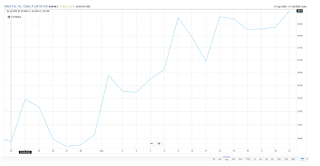Vonage Holdings Corp. (NASDAQ:VG, $10.13): “Securing a Better Future of Communication”
By: Andrew Hoy, AIM Student at Marquette University
Disclosure: The AIM Equity Fund currently holds this position. This article was written by myself, and it expresses my own opinions. I am not receiving compensation for it and I have no business relationship with any company whose stock is mentioned in this article.
Summary
• Vonage Holdings Corp. (NYSE:VG) is leading provider of Voice over Internet Protocol (VOIP) technology in the United States. They offer an expansive portfolio of communication services to mainly enterprise customers, which include but aren’t limited to Unified Communication as a Service, Communication Platforms as a Service, and Contact Centers as a Service.
• Revenue mix transition intact. API revenue 47% of enterprise revenue in Q2, up from 40% and 20% from FY19 and FY18 respectively. The segment accelerated 163% YoY in Q2, partially driven by an increase in demand from COVID-19. The growth in their API segment was a key factor in the Enterprise Segment’s overall 18% YoY growth.
• Consumer Segment Deliberation. As Vonage continues to move towards optimizing their business model, the company’s legacy Consumer continues to lag the explosive growth realized in the Enterprise segment. As a result, management is deciding whether to divest this revenue stream completely.
• Reworking Go-To-Market Strategy. While they offer a comprehensive range of cloud-based communication solutions, each individual market is fragmented because customers often pick and choose between offerings instead of buying the entire portfolio. Management recently identified the need for an improved go-to-market strategy in application software offerings and reiterated that they are making changes to improve top-line growth.
Key points:
As the company’s product portfolio becomes increasingly developed, the downstream opportunities continue to follow suit. One recent development is the company’s entry into the Telehealth market. In May of 2019 they became HIPPA compliant, reinforcing their position as a market leader in both security and product depth. Vonage is disrupting the industry because their developer-focused pipeline allows them to provide customers with customized solutions at scale. As a result, they are introducing novel features like AI to analyze facial expressions and conduct sentiment analysis to evaluate a patient’s underlying mental condition.
Additionally, year-to-date Sales have slightly lagged modeled expectations. In the first and second quarters of this year, total revenue is on track to slightly miss the originally projected 10% revenue growth. Q1 and Q2 saw top-line sales growth of 6.4% and 4.4% respectively. Extrapolated over the following two quarters, this puts them in-line to earn ~$1,205mm in top-line revenue for FY20. Additionally, Vonage improved their EBITDA margin from -0.86% to 1.29% in Q1, and Q2 EBITDA margins of 0.78%.
Compared to most of the industry, Vonage’s key competitive moat continues to be its stackable product portfolio. Under the OneVonage umbrella, they add value by providing market-leading geographic reach, security, customer service and scalability. To ensure the best quality coverage, they periodically assess the locations of regional data connection points and transfer calls to other carriers as needed. Vonage continues to improve their customers’ experiences through strategic alliances with several service providers to grow their geographic footprint.
What has the stock done lately?
VG’s share price has dropped 22% from its early august high at $12.99 after reporting second quarter earnings. Valued at $15/share in 2019, the market began discounting the company’s shares because of the uncertainty surrounding the large number of acquisitions (eight in the past two years) Vonage had undertaken. This continues to be a period of transition for Vonage as they shift to an enterprise customer focus. Adoption of remote-communication software solutions in the enterprise market was accelerated by the COVID-19 pandemic, and their focus on driving growth through offering ease of use and rapid customization has really taken off with their API’s posting 160% growth in the Q2’19.
Past Year Performance:
Vonage’s share price put in a bottom at $4.19 in mid-March. From there, it grew 141% and is currently holding around the $10 mark. Volatility has been decreasing, reflecting an enduring change to investor sentiment. While a 22% pullback is quite a lot, when put into perspective I believe it is a healthy correction given the scale of the moves the stock has experienced. Prior to COVID-19, the stock was underperforming its benchmark. Post-pandemic, the market realized the potential for growth, but ahead of itself in terms of valuation. I think that as the transition period comes to a close, Vonage’s shares will continue to rise in the same manner they have YTD.
My Takeaways:
Vonage was originally pitched to the AIM Small-Cap Equity Fund with a price target of $12.32, representing a 63% upside. From the execution price of $6.88 the stock has delivered a 47% return to date and continues to offer growth potential to the portfolio. Margin stabilization, along with a potential divestiture of the residential business are a couple key factors the market is currently weighing. I recommend that the AIM fund continue holding Vonage as of 9/27/20.





































